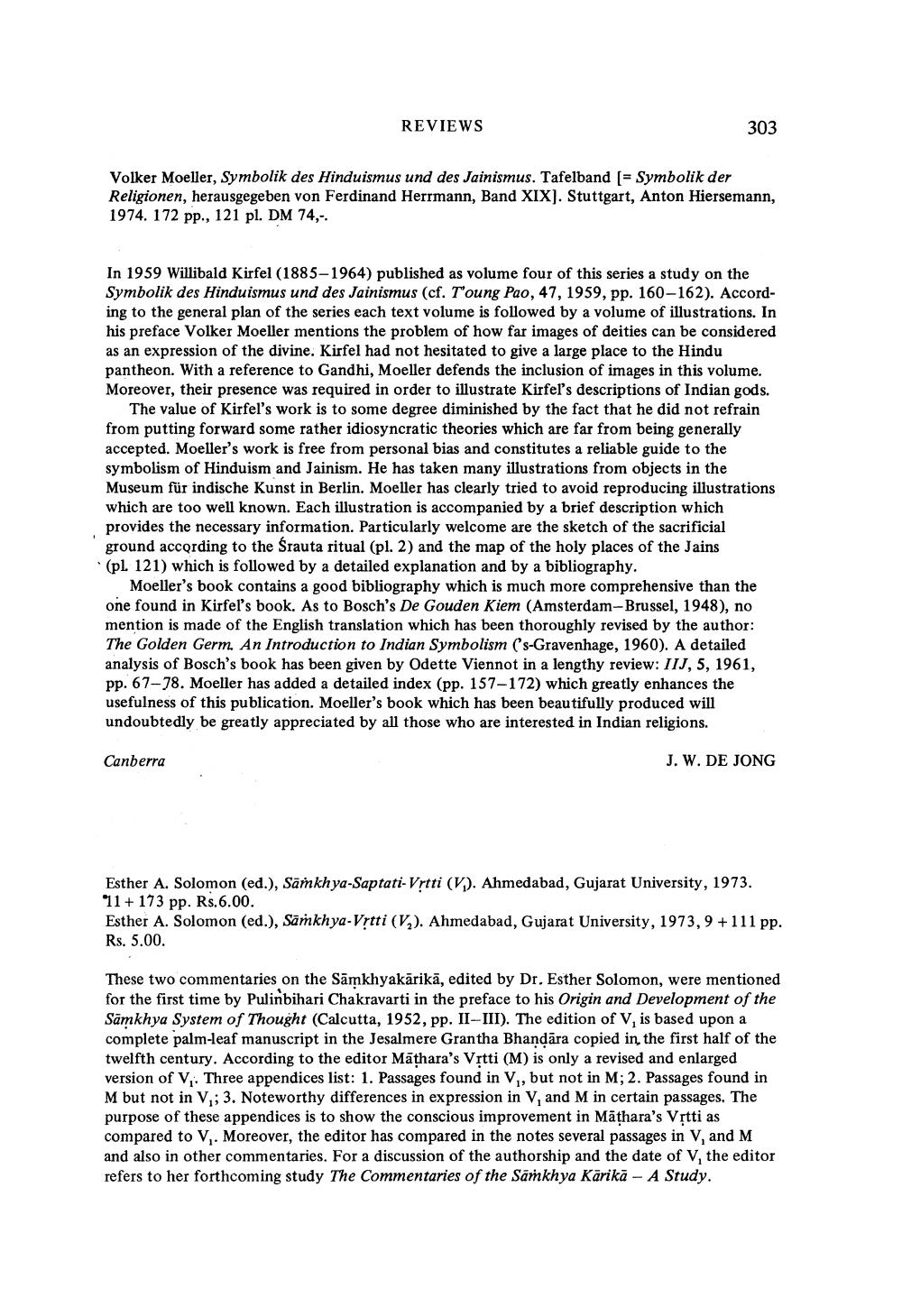Book Title: Reviews Of Different Books Author(s): J W De Jong Publisher: J W De Jong View full book textPage 7
________________ REVIEWS 303 Volker Moeller, Symbolik des Hinduismus und des Jainismus. Tafelband (= Symbolik der Religionen, herausgegeben von Ferdinand Herrmann, Band XIX). Stuttgart, Anton Hiersemann, 1974. 172 pp., 121 pl. DM 74, In 1959 Willibald Kirfel (1885-1964) published as volume four of this series a study on the Symbolik des Hinduismus und des Jainismus (cf. T'oung Pao, 47, 1959, pp. 160-162). According to the general plan of the series each text volume is followed by a volume of illustrations. In his preface Volker Moeller mentions the problem of how far images of deities can be considered as an expression of the divine. Kirfel had not hesitated to give a large place to the Hindu pantheon. With a reference to Gandhi, Moeller defends the inclusion of images in this volume. Moreover, their presence was required in order to illustrate Kirfel's descriptions of Indian gods. The value of Kirfel's work is to some degree diminished by the fact that he did not refrain from putting forward some rather idiosyncratic theories which are far from being generally accepted. Moeller's work is free from personal bias and constitutes a reliable guide to the symbolism of Hinduism and Jainism. He has taken many illustrations from objects in the Museum für indische Kunst in Berlin. Moeller has clearly tried to avoid reproducing illustrations which are too well known. Each illustration is accompanied by a brief description which provides the necessary information. Particularly welcome are the sketch of the sacrificial ground according to the Srauta ritual (pl. 2) and the map of the holy places of the Jains (pl. 121) which is followed by a detailed explanation and by a bibliography. Moeller's book contains a good bibliography which is much more comprehensive than the one found in Kirfel's book. As to Bosch's De Gouden Kiem (Amsterdam-Brussel, 1948), no mention is made of the English translation which has been thoroughly revised by the author: The Golden Germ. An Introduction to Indian Symbolism ('s-Gravenhage, 1960). A detailed analysis of Bosch's book has been given by Odette Viennot in a lengthy review: IIJ, 5, 1961, pp. 67-78. Moeller has added a detailed index (pp. 157-172) which greatly enhances the usefulness of this publication. Moeller's book which has been beautifully produced will undoubtedly be greatly appreciated by all those who are interested in Indian religions. Canberra J. W. DE JONG Esther A. Solomon (ed.), Samkhya-Saptati-Vrtti (V). Ahmedabad, Gujarat University, 1973. '11 + 173 pp. Rs.6.00. Esther A. Solomon (ed.), Samkhya-Vịtti (V). Ahmedabad, Gujarat University, 1973,9 +111 pp. Rs. 5.00. These two commentaries on the Sāmkhyakārikā, edited by Dr. Esther Solomon, were mentioned for the first time by Pulinbihari Chakravarti in the preface to his Origin and Development of the Samkhya System of Thought (Calcutta, 1952, pp. II-III). The edition of V, is based upon a complete palm-leaf manuscript in the Jesalmere Grantha Bhandāra copied in the first half of the twelfth century. According to the editor Mathara's Vịtti (M) is only a revised and enlarged version of V.. Three appendices list: 1. Passages found in V., but not in M; 2. Passages found in M but not in V,; 3. Noteworthy differences in expression in V, and M in certain passages. The purpose of these appendices is to show the conscious improvement in Māthara's Vịtti as compared to V. Moreover, the editor has compared in the notes several passages in V, and M and also in other commentaries. For a discussion of the authorship and the date of V, the editor refers to her forthcoming study The Commentaries of the Samkhya Karikā - A Study.Page Navigation
1 ... 5 6 7 8 9 10 11 12 13 14 15 16 17 18 19 20 21 22 23 24 25 26 27 28 29 30 31 32
